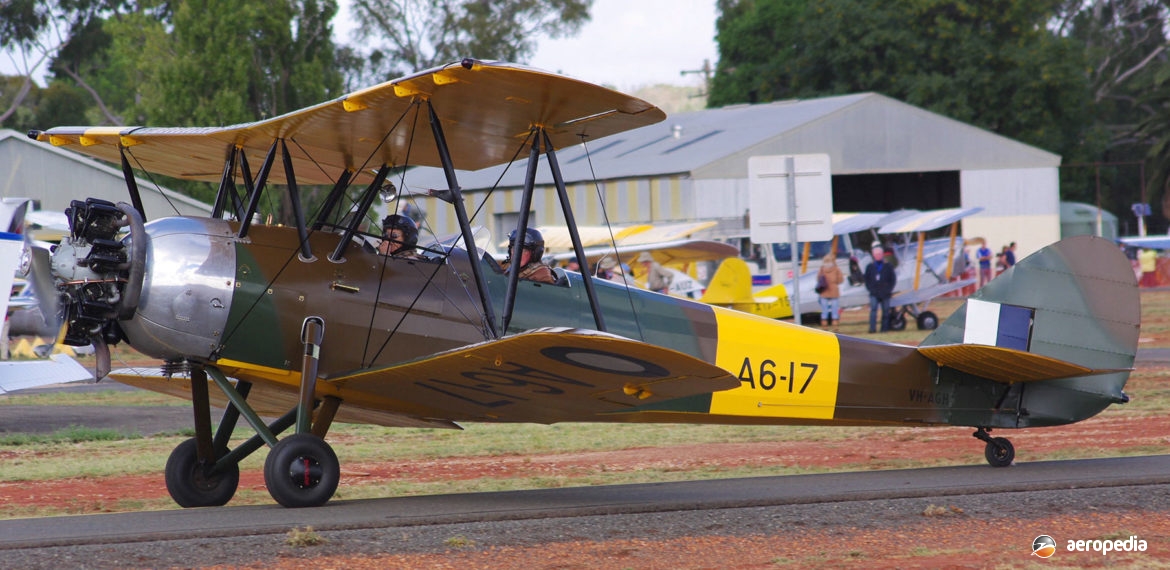Photograph:
Avro 643 Cadet Mk II VH-AGH / A6-17 at Griffith, NSW in 2012 (David C Eyre)
Country of origin:
United Kingdom
Description:
Two-seat military training biplane
Power Plant:
One 112 kw (150 hp) Armstrong Siddeley Genet Major 1A five-cylinder air-cooled radial engine
Specifications:
- Wingspan: 9.2 m (30 ft 2 in)
- Length: 7.54 m (24 ft 9 in)
- Height: 2.7 m (8 ft 10 in)
- Wing area: 24.34 m² (262 sq ft)
- Max speed: 187 km/h (116 mph)
- Cruising speed: 161 km/h (100 mph)
- Initial rate of climb: 213 m/min (700 ft/min)
- Ceiling: 3,657 m (12,000 ft)
- Range: 523 km (325 miles)
- Empty weight: 583 kg (1,286 lb)
- Loaded weight: 907 kg (2,000 lb)
History:
Released in 1931 as a scaled-down Avro Tutor, the Model 631 Cadet was produced in a number of variants, one of which was the Avro 643 Cadet Mk II, 34 examples of which were employed by the RAAF as trainers (serials A6-1 to A6-34), and these were known as the Cadet or Avro Trainer.
The prototype Model 631 Cadet G-ABRS was used as a demonstrator by the manufacturer, A V Roe & Co Ltd. Largest operator of the type was Air Service Training Ltd at Hamble in Hampshire. This company had an associate, the Far East Aviation School in Hong Kong, which obtained the prototype and a number of other examples. The type also saw service with the Irish Air Corps.
In September 1934 the Model 643 Cadet was introduced, being an improvement on the Model 631 with a raised rear seat, the prototype of this model being G-ACXJ, but only a small number was produced. They were replaced on the production line by the Model 643 Mk II.
The Mk II model was built for the RAAF and for the English company called Air Service Training Ltd. The Mk II differed from the Mk I in having a 112 kw (150 hp) Armstrong Siddeley Genet Major engine in place of the 101 kw (135 hp) engine in the earlier aircraft, the engine being mounted further forward by 15 cm (6 in), the bracing wires being taken to the front wing root fittings for ease of escape by parachute from the front cockpit, and it having an inverted fuel system. The prototype of this model G-ADJT was exported to France as F-AQMX in 1938.
Of the 34 aircraft delivered to the RAAF, some 17 survived RAAF training service, were converted to civil use and appeared on the Australian Civil Register after World War II, a few being converted for agricultural duties. Two aircraft VH-AFY (c/n 1066 – ex A6-31) and VH-AFX (c/n 861 – ex A6-12) were fitted with a 164 kw (220 hp) Jacobs R-755 radial engine, which improved their performance substantially.
Cadets registered in Australia have included: VH-AEG (c/n 854 – ex A6-5); VH-AEH (c/n 991 – ex A6-18) which later became VH-PRV; VH-AEI (c/n 1060 – ex A6-25) which later became VH-PRU; VH-AEL (c/n 1068 – ex A6-33); VH-AFW (c/n 860 – A6-11); VH-AFX (see above); VH-AFY (see above); VH-AFZ (c/n 994 – ex A6-21 ) which later became VH-RAC; VH-AGC (c/n 1067 – ex A6-32) which later became VH-BPS and VH-PRT; VH-AGH (c/n 990 – ex A6-17); VH-AHH (c/n 1058 – ex A6-23); VH-AHI (c/n 1069 – ex A6-34) which later became VH-BJB, which at one stage was fitted with an enclosed sliding hood from a CAC Wackett; VH-AHW (c/n 1062 – ex A6-27); VH-APV (c/n 851 – ex A6-2); VH-AMM (c/n 859 – ex A6-10); and VH-APW (c/n 1063 – ex A6-28).
By the 21st century a total of 14 examples is believed to survive in this region. Airworthy examples have included VH-PRT (c/n 1067) and VH-AFX (see above). Another, VH-PRU/A6-25 (c/n 1060), was restored to airworthiness and painted in RAAF markings in the late 1990s at Murwillumbah, NSW. It was based for a period at the RAN Museum at Nowra, NSW but in 1999 it was exported to the Kermit Weeks collection at the Museum of Flight at Polk City in Florida in the USA as N643AV. Another, VH-RUO (c/n 1069 – ex A6-34), was restored at Shepparton, VIC and is now with the RAAF Museum at Point Cook, VIC.
Work has been progressing on restoring others, including VH-AEJ / A3-8 (c/n 857), which was completed and flown in 2008; VH-AGH (ex A6-17) also completed in 2008 and finished in RAAF World War II camouflage; and VH-PRT (ex A6-32) under restoration.
One was imported to New Zealand from the United Kingdom in 1999, this being a Model 631 Cadet, becoming ZK-AVR (c/n 730 – ex C7, EI-AGO, G-ACFM). After restoration, in 2006, it was re-exported to Ireland.

